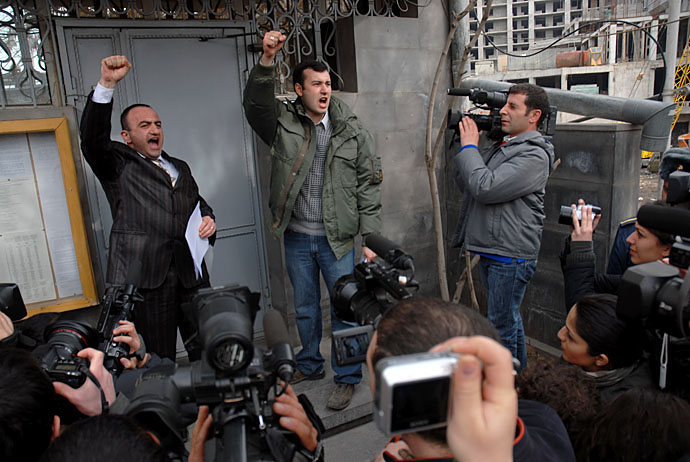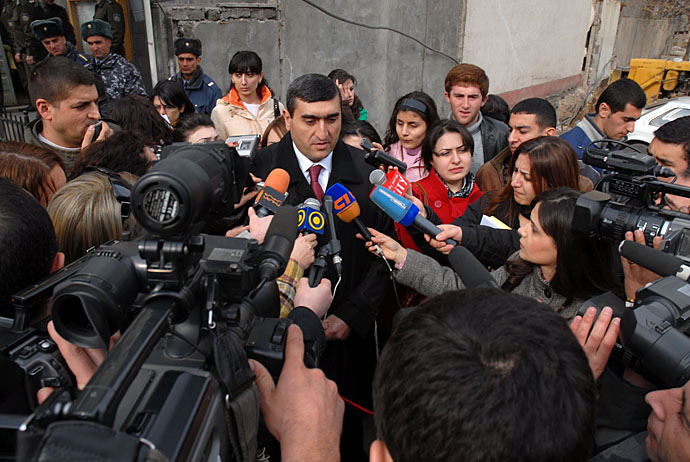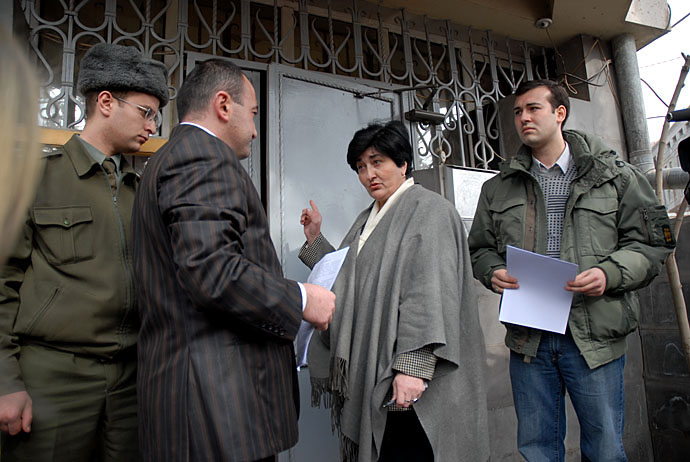



« back to Onnik Krikorian in Armenia home




Well, thanks to a sub-standard Internet connection from the appallingly bad Beeline ISP in Armenia looks like I've lost my post on the HRW 1 March report. Been searching on the Internet to find out how to retrieve what might have been auto-saved but can'tr find anything. So, unless anyone has some suggestions, just read the report on the 1 March 2008 post-election violence in Armenia at the link given above.
Interesting that the demonstration's organizers didn't bother to translate their letter into Georgian first before handing it over to the embassy. They just gave the embassy a potentially good reason for it not going any further -- "technical reasons." Guess it's a reflection of the age-old cultural tug-of-war between both sides?
Baku-based Regional Analyst Paul Goble has this to say on Samtskhe-Javakheti, the sudden and disproportionate coverage in the Armenian media, and suspicions that Russia is behind stirring up trouble in the region.
WindowonEurasia: Window on Eurasia: Moscow’s Program to Dismember Georgia[...] perhaps most important at the present time, it calls attention to Moscow’s ongoing efforts to exacerbate tensions in the Armenian-populated portion of southern Georgia, Samtskhe-Javakhetia, and put that region in play against Tbilisi in much the same way it sought to exploit Abkhazia and South Ossetia.
[...]
On the one, Georgian officials point out, the situation in Samtskhe-Javekhetia is relatively calm, the result they suggest of the arrest of two extremists that has sparked so much controversy and of Tbilisi’s support for new roads and Armenian-language schools there. Indeed, the “language” problem in that region is for ethnic Georgians there who have only one school.
And on the other, they point to the fact that it has been the ethnic Armenian Javakhetian diaspora in Moscow that has taken the lead in trying to attract attention to that region’s “aspirations.” Last week, for example, this diaspora released an open letter calling on Armenia, Russia, and Georgians (as opposed to the Georgian government) to help them.
[...]
But even though both the ombudsman for the Georgian government and human rights activists who have visited Samtskhe-Javakhetia in recent weeks say that the situation there is normal and calm, more stories to the contrary are likely to appear not only in Armenia where attention to this area might seem entirely natural but also in Moscow where it clearly is not.
And such articles, appeals, and demonstrations outside of Samtskhe-Javakhetia on behalf of that region are, according to Tbilisi’s Bayburt, clear evidence that “Russia is doing everything it can to provoke the rise of separatism in Georgia and in particular in [that] region where Armenians live in a compact group.”
http://windowoneurasia.blogspot.com/2009/02/window-on-eurasia-moscows-program-to.html
Looks like there are more journalists covering the event than the actual participants. Must have been a slow news day.
Nazarian, there were about 70 protesters behind the journalists interspersed between construction trucks doing whatever they're doing on that street. But yes, the number of journalists as a percentage for such a low profile event was very noticeable indeed. On the subject of the media, to be honest, I just don't think the TV especially is covering the type of subjects it should be and I'm sure the presence of an MP from the ruling Republican Party had something to do with it.
Timing with the HRW/US State Department reports might have been coincidental, but for sure the demo managed to keep those from sufficient or any coverage in many media outlets. Foreign policy issues seem to serve such purposes in deflecting attention from internal political problems worldwide, but especially in this region. Anyway, for sure there are issues facing minorities in the region, and especially Georgia, but most seem to frame these types of activities in another context.
Interestingly, however, there weren't any Dashnaks in sight.
Interestingly, just came back from my local kiosk where they have a television perched up high to pass the time in between customers and Mitq was live on air talking about Samtskhe-Javakheti. Of course, there was no Georgian representative present to engage in actual discussion and debate or even to counter any claims made.
Meanwhile, one has to wonder whether the local media reported sufficiently enough on the release today of a report by Human Rights Watch which accuses the Armenian police of the disproportionate use of force in the post-election clash with opposition supporters almost a year ago to the day during which 10 people died.
http://www.hrw.org/en/reports/2009/02/25/democracy-rocky-ground-0
There will be something on Frontline about the report later, but for now, suffice to say that those online media outlets I've just checked which have been most prolific in constantly pushing nationalist perspectives on Azerbaijan, Georgia and Turkey this week have failed to mention the HRW report. Perhaps it escaped their notice.